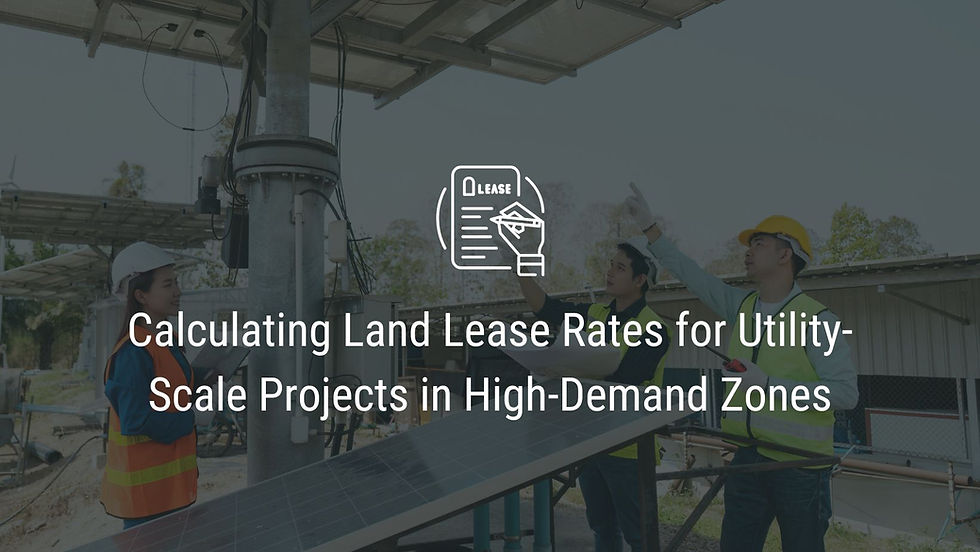The Modern Landman: Renewable Energy Prospecting
- Yoann Hispa

- Jan 16
- 3 min read

The position of a landman has always been essential in the energy industry. But what is a landman? Typically, landmen act as intermediaries, negotiating leases with landowners to facilitate the exploration and development of minerals, oil, and gas. They represent energy companies publicly, handling relationships and ensuring seamless transactions.
However, with the rise of renewable energy and advanced data platforms like LandGate, the landscape for the modern landman is shifting dramatically.
The Traditional Role of a Landman
Throughout history, the landman have been crucial to the oil and gas sector. Their duties have included:
Negotiating Leases: Interacting with landowners to secure rights for mineral exploration.
Title Research: Examining property ownership and confirming legal statuses.
Regulatory Compliance: Making sure all operations adhere to local, state, and federal laws.
Coordination: Collaborating with geologists, engineers, and other experts to support exploration and production efforts.
Landmen can be categorized into different types:
In-House Landmen: Staff members within an energy corporation.
Independent Field Landmen: Freelancers who operate on a project-by-project basis.
Independent Land Consultants: Specialists offering expert advice and services.
2025 Changes Impacting the Landman Role
With the advent of renewable energy projects and advancements in technology, the role of the landman is undergoing significant transformation. Here are some key changes:
Shift to Renewable Energy Projects
Landmen are no longer confined to oil and gas projects. They are now sourcing sites for solar, wind, and other renewable energy projects. This shift requires a different set of skills and knowledge, including an understanding of zoning laws, environmental impacts, and community relations specific to renewable energy. In fact, the AAPL (American Association of Professional Landmen) now offers renewable-specific certification to their membership.
Use of Advanced Data Platforms
Data platforms like LandGate are revolutionizing how landmen operate. These tools provide comprehensive datasets, including land ownership, mineral rights, environmental assessments, and financial analyses. By leveraging such platforms, landmen can:
Identify Optimal Sites: Quickly locate suitable properties for various energy projects.
Analyze Data Efficiently: Access real-time data and analytics to make informed decisions.
Streamline Negotiations: Use detailed property insights to negotiate better terms with landowners.
Looking Ahead: The Renewable Energy Future of the Landman Role
The future of the landman role will likely see further integration with technology and a continued focus on renewable energy. Here’s what we can expect:
Increased Reliance on AI and Machine Learning
Artificial intelligence and machine learning algorithms will play a significant role in site selection and data analysis. These technologies can predict the best locations for energy projects by analyzing vast amounts of data, including weather patterns, land use, and economic factors.
Expanded Skill Sets
Future landmen will need to possess a broader range of skills, including:
Technical Knowledge: Understanding both traditional energy and renewable energy technologies.
Data Analytics: Proficiency in using data platforms and interpreting complex datasets.
Community Engagement: Building strong relationships with communities and stakeholders to gain support for projects.
Enhanced Regulatory Knowledge
As the energy sector continues to evolve, so too will the regulatory landscape. Landmen will need to stay abreast of changing laws and regulations related to both fossil fuels and renewable energy sources.
Landman Industry Outlook
The role of a landman is evolving rapidly in response to the rise of renewable energy and the advent of advanced data platforms like LandGate. While the core responsibilities remain—negotiating leases, conducting title research, and ensuring regulatory compliance—the scope and tools of the job are expanding. Landmen are now at the forefront of sourcing and developing renewable energy projects, equipped with cutting-edge technologies that make their work more efficient and impactful.
For those interested in pursuing a career in this dynamic field, the future looks bright. Adaptability, continuous learning, and a keen understanding of both traditional and emerging energy sectors will be key to success. To learn more, book a demo with a member of our dedicated energy markets team.


